The Fire Army,[1][2] also known as the Fire Nation Army,[3][4] is the land warfare service branch of the military of the Fire Nation. Considered the most powerful army of the world for a significant part of its history,[5] the Fire Army is a standing force loyal to the Fire Lords. As a result, it played a major part in keeping the Fire Nation's noble clans in check when they still maintained private militias,[2] and was also crucial in many wars fought by the Fire Nation, most importantly the Hundred Year War, when the Fire Army overran large parts of the Earth Kingdom and took part in the Air Nomad Genocide.
The Fire Army is traditionally comprised of firebending as well as nonbending soldiers who operate as infantry, cavalry, and artillery. For much of its history, the Fire Army included male and female soldiers, though the latter became a small minority at some point after the 3rd century BG. The Fire Army traditionally emphasizes hard training, esprit de corps, aggressive strategies, and up-to-date technologies, making it capable of almost any military ground operation.[5]
History[]
Early history[]
At some point during or after the unification wars of the Fire Islands, the Fire Army was organized as standing force. It served as important medium to keep the Fire Lords in power in the face of the country's powerful noble clans which maintained household troops and regularly engaged to destructive feuds. Several times during the Fire Nation's history, the country descended into civil war.[2][6] In comparison to the clans' militias, the Fire Army was a much more elite force, but also much smaller. As a result, Fire Lords usually had to rely on at least some clans and their military might to maintain power.[6] To protect the country's ruler, the army often sought out look-alikes among the common people and recruited them as political decoys to draw out assassins.[7]
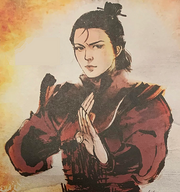
After the death of Avatar Kuruk, an elite Fire Army soldier named Rangi was appointed the bodyguard to the next Avatar, initially presumed to be Yun.[1] Rangi eventually became the girlfriend of Kuruk's true successor, Kyoshi, and aided her during her quests.[8]
In 295 BG, Fire Lord Zoryu contemplated to completely integrate the disgraced Saowon clan into the Fire Army. As the clan had previously opposed him during the Camellia-Peony War and maintained an independent streak, he quickly dropped the idea.[2] In the following centuries, the Fire Army grew in power, while the clan militias declined.[9]
Consolidation and expansion under Sozin[]
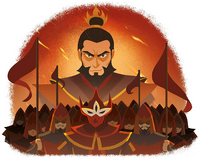
Starting early in his reign, Sozin expanded the Fire Army to prepare for his wars of conquest.
In the first years of Fire Lord Sozin's rule from 58 BG, the Fire Nation experienced its last violent conflict between the noble clans. Led by General Oraso Eiko, the Fire Army intervened in Sozin's name and defeated the warring factions, finally uniting the Fire Nation completely under the Fire Lords.[9] In the next years, Sozin began to expand the military;[9][10] some members of the army including Oraso Eiko expressed opposition to his increasingly expansionist outlook and support for the Fire Navy, wishing for the military to focus on internal safety.[9] However, most of the army remained firmly loyal. At some point in his early reign, Sozin used the army to occupy the Fire & Air Center of Learning, officially to protect local citizens from attacks by the Guiding Wind. In truth, the action aimed at severing the growing ties between the Fire Nation nobility and the Air Nomads.[11][10] Fire Army guards under Captain Enaka also assumed responsibility for the safety of the Four Nations Summit & Technological Symposium.[12]
Around 37 BG, the Fire Army successfully attacked and occupied a region of the western Earth Kingdom on the order of Fire Lord Sozin. The conquered territories were designated as colonial possessions, and although Sozin had intents to take over more land, his plans were halted by Avatar Roku, who opposed aggression and imperialism. Nevertheless, the status of these first colonies did not change, and they continued to serve as bases of operation for the military.[13][14] In the following years, Sozin further expanded the Fire Army.[3]
The Hundred Year War[]
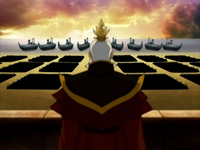
Fire Lord Sozin oversaw an assembly of army and navy troops before starting the Hundred Year War.
In 0 BG, Sozin launched the Hundred Year War. At first, the Fire Army harnessed the power of Sozin's Comet to destroy the Air Nomads, though not without suffering heavy casualties from the resisting airbenders. However, the soldiers failed to kill Avatar Aang, who escaped before the Air Nomads were all killed.[15] After destroying a whole nation, the Fire Nation troops began to fight the two remaining hostile nations, the Water Tribes and the Earth Kingdom. Using the colonies as bridgeheads, they destroyed many Earth Kingdom cities in the following years, devastating the western kingdom. The army won many battles during these early stages of the war, including the Battle of Han Tui, the Battle of Garsai,[16] and the infamous destruction of Taku.[17]
After Sozin's death and Fire Lord Azulon's crowning, the Fire Army achieved even more victories. Around 40 AG, the army joined forces with the Fire Navy and attacked the Southern Water Tribe, killing or imprisoning all of the waterbenders there, leaving only the nonbenders to suffer constant Fire Navy raids for the next several decades.[18] For the rest of Azulon's reign, the army fought the Earth Kingdom and succeeded in conquering most of its western territory. The Fire Nation troops left much suffering and destruction in their wake.[5] At one point during Azulon's rule, the army put down an uprising that engulfed several colonies.[19]
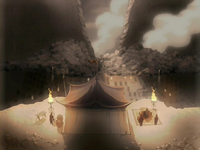
There was a Fire Nation camp outside the walls of Ba Sing Se during the six-hundred day siege.
In 94 AG, General Iroh led the army in attacking the Earth Kingdom capital of Ba Sing Se in a six hundred-day siege. The army breached the Outer Wall and attacked the Agrarian Zone, only to be pushed back soon after when Iroh called a retreat after earthbenders killed his son, Prince Lu Ten.[16] This failed attack would dishonor Iroh for years to come. Nevertheless, it was the first time that an army had been able to breach through the walls of Ba Sing Se, something even previous earthbending armies had not accomplished. Therefore, the siege had a major impact on the morale of both fighting armies – while the morale of the Fire Army was boosted, the Earth Kingdom soldiers faced a terrible shock.[5] The Fire Army also continued its advances in other parts of the Earth Kingdom, capturing large parts of the nation's interior provinces. However, as the Fire Nation expanded its occupation, it became increasingly vulnerable to widespread guerrilla warfare by Earth Kingdom loyalists and Water Tribe volunteers. Thus, even as the Fire Army kept pushing back the Earth Kingdom Army, its isolated garrisons were suffering under repeated partisan attacks.[20][21] At some point during Ozai's reign, a prominent Fire Army general named Onomu tried to defect to the Earth Kingdom.[22]
During the year in which Avatar Aang awoke from the iceberg, namely late 99 AG, the Fire Army prepared several several massive offensives to end the already crumbling resistance of the Earth Kingdom and the Northern Water Tribe. In one operation, Fire Army forces under Masaru captured the stronghold of Shen Guan near Omashu.[23] Following the fall of Shen Guan, Masaru's unit embarked on a quest to capture valuable and unique texts which could aid the Fire Nation war effort, fighting at Razor Reef and Hegemon's Folly.[24][25] Meanwhile, the garrison of Ketu Harbor successfully fought off a number of pirate attacks.[26]
However, around this time and due to Team Avatar's involvement, more uprisings of earthbenders and Earth Kingdom civilians in occupied territories began to occur. After several imprisoned earthbenders were able to escape from a Fire Nation prison rig, they formed a militia and began to fight the army in a guerrilla war at the western Earth Kingdom coast.[13] The rebels and allied Earth Kingdom Army forces eventually captured the prison rig itself, turning it into a local resistance base; the Fire Army and Fire Navy unsuccessfully attempted to retake the rig.[27] Another obstacle to the Fire Nation rule that had arisen in the western kingdom were the Freedom Fighters, a guerrilla group determined to rid the world of all firebenders. While the latter was dissolved after a scuffle with the more moderate Team Avatar, the former remained active until summer 100 AG.[28] The army faced considerable difficulties in hunting down these guerrillas and minimize the damage they did to logistics, infrastructure and colonies.[5] Furthermore, Commander Mamushi of the Fire Navy enlisted a contingent of Fire Army soldiers under Gyaku to support a self-serving mission to the eastern South Pole region; Mamushi ultimately left these troops to their fate.[29]
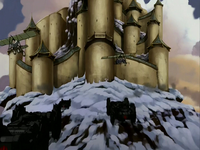
The Fire Army, spearheaded by tundra tanks, attempted to conquer the Northern Air Temple.
In early 100 AG, the army tried to conquer the Northern Air Temple a second time, since local refugees living in the temple had opposed the authority of the Fire Nation. The army employed hundreds of foot soldiers and a contingent of tanks to overwhelm the defenders in their almost inaccessible mountain fortress, accessible by only a single path. Despite considerable resistance from the refugees, their air forces, and Team Avatar, the tanks soon reached the walls of the temple. The battle ultimately ended in a defeat, however, as the defenders, in a last desperate act, intentionally caused a massive natural gas explosion under the temple; both the cliffs and path to the temple were destroyed, while almost all Fire Nation forces were killed in the explosion. The confrontation was not a complete loss, however, as War Minister Qin discovered an abandoned hot air balloon during the battle, technology that would give the Fire Nation a major advantage during the final stages of the war.[30]
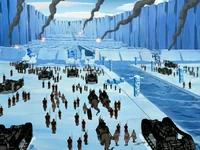
The Fire Nation siege force advancing toward the Northern Water Tribe.
Later on, Admiral Zhao launched a massive invasion force to attack the Northern Water Tribe in what is now known as the Siege of the North. Thousands of soldiers and dozens of tanks attacked the Water Tribe Capital, but they were met by the extremely powerful waterbenders who defended the city.[31] When Zhao killed the Moon Spirit, the Fire Army had full control of the city, but they were annihilated by Avatar Aang when he became one with the all-powerful Ocean Spirit. Any remaining survivors retreated, while Zhao was imprisoned in the Fog of Lost Souls in the Spirit World.[32] The Moon Spirit was soon restored due to Yue's sacrifice and the Water Tribe was saved.[33]
Sometime later, the Fire Army conquered the Earth Kingdom city of Omashu and replaced the imprisoned King Bumi with one of the Fire Nation's governors. Despite the Omashu Resistance, the Fire Nation forces had a strong hold on the city. With the fall of Omashu, later renamed New Ozai, the Fire Army occupied almost all of the western and northern Earth Kingdom territories.[34]
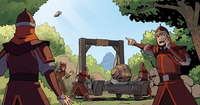
A Fire Army artillery unit prepares to launch a surprise attack on Team Avatar as they fly by on Appa.
A few weeks later, a Fire Army artillery unit chanced upon Team Avatar, and used their catapults to launch a surprise attack. Although the soldiers failed to inflict any casualties, they separated Katara from her friends. Soon after, a soldier of the unit encountered the Avatar and his friends, challenging them only to be easily defeated. Around the same time, the Fire Army garrison of an occupied village failed to stop Jiang's pirates from breaking through a river blockade.[35] After a successful coup d'état led by Princess Azula and the Dai Li, the Fire Army occupied Ba Sing Se, finally conquering the capital of the Earth Kingdom.[36]
The Fire Army was left in almost complete control of the Earth Kingdom with the fall of its mighty capital and Avatar Aang's defeat. However, even with Ba Sing Se in its control, the Fire Army was met with a determined resistance who threatened the army's hold of the country, even pushing back the army in territories of secondary importance.[37] On the Day of Black Sun, the Fire Army suffered a crushing defeat when King Bumi broke out of prison in Omashu and took advantage of the army's temporary loss of firebending to single handedly liberate his city.[38]

The Fire Army was outmatched by deserter Jeong Jeong during the liberation of Ba Sing Se.
The Fire Army's final defeat came with the liberation of Ba Sing Se on the return of Sozin's Comet, when the Order of the White Lotus assaulted the city and utterly crushed the occupying forces with their advanced bending skills. The defeat of Fire Lord Ozai in the concurrent battle at Wulong Forest and Azula's downfall during an Agni Kai with her brother effectively secured the surrender of the Fire Army.[38]
With the end of the Hundred Year War, Zuko was crowned the new Fire Lord, announcing world peace, while the army, now under his control, withdrew from the occupied territories all over the world.[39]
Manpower reduction and Harmony Restoration Movement[]
Throughout the following year, the Fire Army was reduced in size and reformed. This action caused many military personnel to lose their occupations.[39][40] Many ex-soldiers felt "lost" after their country's unexpected defeat, having no proper place to belong in the new peaceful times.[41] Several consequently set out on their own,[41] with some becoming mercenaries.[39] Old Fire Army equipment including uniforms and armour also found its way into the hands of crime groups.[42]
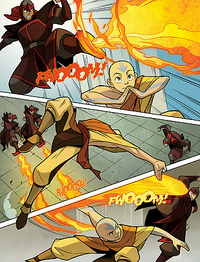
Firebending guards fighting Aang to drive him out of Yu Dao.
The Fire Army remained inactive until the escalation of the tensions surrounding the Harmony Restoration Movement in 101 AG. After recognizing that reforming the Fire Nation colonies was a better and less disruptive solution than total abandonment, Fire Lord Zuko officially withdrew his support of the Harmony Restoration Movement. He barricaded Yu Dao, the most significant colony and main opponent of the movement, announcing that no one was to leave or enter the city without his permission. His order was enforced by the Fire Army troops that were stationed in the city.
Zuko's decision resulted in protests of Earth Kingdom loyalists, especially the Freedom Fighters. However, nonbending guards of the Fire Army protected Yu Dao from these protesters.
Later on, when Avatar Aang arrived, he and Katara easily entered the city via the Avatar's glider staff. In Yu Dao, they were warned by firebending guards to leave the city since they had no permission, but the Avatar demanded to speak with Zuko. The dutiful guards attacked the Avatar, but were easily defeated by Katara. One soldier tried to attack again, but the waterbender geared up to harm him before Zuko appeared, grabbing and admonishing her for attacking his people. His arrival led to a scuffle, during which Zuko agreed to another talk with Earth King Kuei in hopes of achieving future peace.[14]
However, when General Mak informed Zuko later on that Earth King Kuei was preparing to invade Yu Dao, the Fire Lord deployed his fleet and army to defend the colony from the Earth Kingdom Army.[43]

The Fire Army attacking during the battle for Yu Dao.
Due to the short time available to him, Zuko employed a small but effective task force of many infantrymen, komodo cavalry, and some tundra tanks to stop the Earth King's army and save Yu Dao. Even though his troops advanced quickly, the Fire Army arrived after the Earth Kingdom Army. When both armies were about to attack each other, Sokka and Toph appeared from one of the tanks which they had secretly hijacked before, and upon Sokka's command, Toph metalbent all the screws from the tundra tanks around them, essentially disabling them. Fire Lord Zuko, outraged and determined, ordered his men to start fighting on foot and with the cavalry, beginning the battle for Yu Dao. In order to avoid unnecessary bloodshed, Team Avatar intervened, fighting both the Fire Nation and Earth Kingdom troops. However, the Fire Army, even without the aid of heavy weapons, was able to withstand both the Earth Kingdom Army with its still operational heavy tanks and the elite fighters of Team Avatar. Nevertheless, Team Avatar's involvement resulted in a ceasefire and an agreement between Earth King Kuei and Fire Lord Zuko, allowing both armies to withdraw peacefully.[40]
Protecting Fire Lord Zuko from usurpation attempts[]

New Ozai Society rebels battle a Fire Army cavalryman during the attack on Iroh's caravan.
The Fire Army worked together with Suki's Kyoshi Warriors to protect Fire Lord Zuko and his family during the usurpation attempts of Ukano around 102 AG. When New Ozai Society rebels prepared to attack Iroh's decoy caravan on the main road from the First Lord's Harbor to the Royal Caldera City, an officer held a speech informing the soldiers that a strike was imminent, yet remained oblivious that New Ozai Society members were already approaching behind him. The insurgents promptly overwhelmed the officer and incapacitated the cavalry, but their assault quickly faltered as the Kyoshi Warriors intervened in support of the cornered soldiers. The army consequently apprehended the New Ozai Society members.[44]
Later on, the capital became plagued by child abductions believed to have been perpetrated by dark spirits. Ukano organized the Safe Nation Society amid these attacks to raise opposition against Zuko and spread unrest among the civilians; having learned that Azula was secretly behind these events, however, Zuko ordered the capital shut down and garrisoned by the Fire Army. As many locals attempted to flee, the gates were blocked by soldiers, while soldiers began to search houses to find evidence of treason by Ukano and the Safe Nation Society. These actions raised opposition by the civilian population, and when General Mak attempted to arrest all Safe Nation Society members, the city descended into chaos: The militants rose up in defiance, supported by dissatisfied civilians, and a riot broke out. After several brawls, the Fire Army brought the situation under control and moved the arrested Safe Nation Society members to the Capital City Prison.[45]
After the crisis at the capital was solved, Fire Army soldiers acted as bodyguards to Zuko during his trip to the South Pole.[46]
Organization[]
Infantry[]
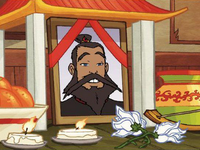
The Fire Army greatly respects self-sacrifice, such as when "Private Wang Fire" was honored after seemingly dying to defeat enemies.
The infantry, as part of a volunteer and standing army, has an excellent moral that borders on fanaticism, is highly trained and very effective. Notably, there are cases of Fire Nation infantrymen known that fought huge monstrosities and spirits head-on without the chance of victory or survival, rather than surrendering, deserting or fleeing. Another example of the almost fanatical mindset of Fire Nation infantrymen was given during the Air Nomad Genocide; to kill a single airbending master, dozens of soldiers gave their lives without retreating. The nonbenders and firebenders fight together in joint companies, often operating with tanks or cavalry. Overall, the Fire Nation infantry is flexible, and due to their high moral and good training, commanders can entrust them with several different tasks.[14][33][40]
However, before the end of the Hundred Year War the army was far larger, and a strict separation of benders and nonbenders both on the equipment and in combat existed. The infamous helmets with faceplates were worn exclusively by firebenders, while nonbenders got only cone helmets.[5] This separation ended under the reign of Fire Lord Zuko, and equipment was issued as needed and by competence. For example, nonbending guards got the infamous red and black armor and faceplates to scare off the Freedom Fighters during the Yu Dao-crisis in 101 AG. In addition to this, after the reforms of Fire Lord Zuko, the formerly vast Fire Army became more compact, but also more effective.[14][40]
Cavalry[]

Komodo rhino cavalry were used during the Siege of the North.
By about 100 AG, the army made use of different mounts for cavalry. Heavy cavalry used komodo rhinos that were outfitted with heavy armor around the face; these animals were also employed for cart pulling, and were even mounted with two catapults. Fire Nation soldiers mount these frightening beasts to terrorize their enemies.[5] Light cavalry used ostrich horses whose heads and front torsos were protected by form-fitting armor.[44]
Artillery[]
By the late Hundred Year War, the Fire Army used at least two types of artillery. The heavier pieces were metal semi-automated trebuchets. They worked by using a large bar holding a metal net with a coal-ball inside it. The coal ball was ignited and a pedal was hit with a mallet causing the bar to fling over and toss the ignited coal-ball into the air. Trebuchets were usually static, however, and could not be easily maneuvered.[47][48] The lighter artillery were smaller metal catapults which had wheels and could be moved more easily.[35]
Personnel[]
Training[]
The Fire Army maintains high standards in training.[1][4] It employs a junior corps to raise elite troops and officers from a young age,[1][49] working in tandem with institutes of learning like the Royal Fire Academy for Girls.[50] The Royal Academy includes an officer's school[49] which teaches tactics, survival and combat training.[50]
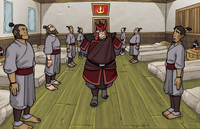
A Fire Nation drill sergeant giving new recruits a terrifying speech.
Regular soldiers enlist at an older age, however, and are subsequently enrolled into several companies and thereafter taken into boot camps. In these camps, they have to endure harsh training, and sometimes also the capriciousness of their officers. However, even though the recruits are driven to the extreme, their training is also effective and strengthens their bodies and minds for the fight. They learn all kinds of different abilities, from necessities like how to handle their weapons or basic discipline to useful extras, like how to ride a komodo rhino in spite of being infantrymen. In addition, the officers often use verbal abuse and the hard training to break the civilian thinking of the recruits, only to raise them again as courageous and pugnacious soldiers.[4]
Despite the fact that the Fire Nation sometimes lacked enough soldiers to effectively secure conquered regions in the vast Earth Kingdom during the Hundred Year War,[37] the Fire Army still relied on massive propaganda to convince volunteers to join the military instead of just forcing people to enlist.[4]
Uniform[]
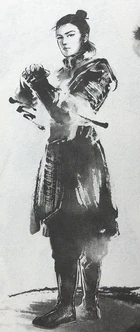
Rangi wearing an officer's uniform in 295 BG.
Fire Nation soldiers are recognizable by their red and black armor. There are types of armor which are equipped for different purposes, while the Fire Nation tends to update their uniforms every so often.
By the early 3rd century BG, common Fire Army troops wore black and red formfitting armor with a small number of spikes.[1][51][52] Officers were given more streamlined armors which had fewer spikes, fewer overhanging flaps, and more gold trimmings.[52] The armor generally consisted of a cuirass, spaulders, gauntlets, and faulds. In contrast to later Fire Nation armor, lamellar armor was used by this time.[53]
By 15 AG, Fire Nation uniforms had large, protruding shoulder spikes. These excessive spikes were once again reduced as the Hundred Year War went on, with armor becoming more streamlined.[31]
By 100 AG, two main types of uniform and armor were in use in the Fire Army. The first type, the heavy armor includes a cuirass, tassets, a combination of shoulder pads and armored collar, and heavy boots. However, most recognizable element is its special helmet with neck guard, a flame-like crest and an intimidating faceplate shaped like an abstract skull. This armor provides excellent protection and is also suited for psychological warfare. The heavy armor is mainly used by heavy infantry and tank crews. Even though ranking officers use this armor, they do not wear faceplates, as they make it difficult to speak properly. In cold climates, the heavy armor is supplemented by lined trousers and a warm jacket.[33][40]
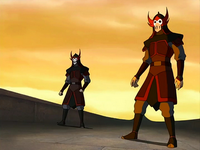
Many firebenders are equipped with heavy armor.
The second type is the light armor. It includes a simple cone helmet with leather neck guard, a combination of shoulder pads and armored collar and a leathern, sleeveless robe, and heavy boots. As the most common armor, it is used by almost two thirds of the infantry. Even though the light armor does not provide excellent protection, it is largely fire resistant and provides adequate protection against projectiles. For the fighting in cold climates lined trousers, a gray overcoat, gloves, a scarf, and a woolen cloak are added to the light armor.[33][40]
Women soldiers[]
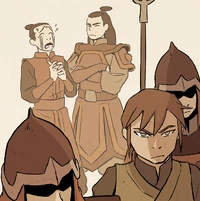
A female Fire Nation general arranged for the arrest of Biyu.
By the time of Avatar Kyoshi, female soldiers were relatively common in the Fire Army, some of whom rose to commanding officers.[54][55] At some point before 99 AG, however, women became a small minority in the army. Instead, they were mostly restricted to service in the Domestic Forces.[56] However, some were still serving at the frontline in the Earth Kingdom by the late Hundred Year War, including General Onomu[22] and one other "prominent" female general. After the latter's son fell in love with Biyu, an Earth Kingdom thief, the general even used her connections to arrange the thief's arrest and imprisonment at the Boiling Rock.[57]
Known members[]
High-ranking officers[]
- Fire Lord Azulon
- Fire Lord Zuko
- General Bujing
- General Iroh
- General Mak
- General Onomu (defected)[21]
- General Oraso Eiko
- General Sheng, leader of the garrison of Laoshan during the late Hundred Year War[21]
- General Shinu
- General Shu, who served within the vicinity of the Si Wong Desert and was Zhao's commanding officer while the latter was a lieutenant.[33]
- Colonel Mongke[58]
- Hei-Ran, who resigned her post to become Avatar Kuruk's firebending master.[54]
Officers[]
- Prison rig warden
- Captain Chey (deserted)
- Captain Enaka[12]
- Captain Masaru[23]
- Captain Tan[59]
- Prison rig captain
- Fire Nation drill sergeant
- First Lieutenant Rangi[60]
- Headmaster (formerly)[61]
- Goro[27]
- Juro[27]
- Sergeant Gyaku[29]
Regular soldiers[]
- Utor[39]
- Overconfident Fire Nation soldier
- Rough Rhinos (served as a squad in the army before becoming mercenaries)[58]
Unknown position[]
Equipment and weaponry[]

Fire Nation infantrymen were equipped with light armor, winter gear, and shields during the Siege of the North.
Nonbending soldiers typically use spears, but sometimes also swords, shields, crossbows, pu dao, halberds and knives as their means of warfare. Firebenders rely mainly on their bending abilities, but they can obtain weapons when it is required, for example in emergency situations like solar eclipse.[5][40]
As the most advanced nation of its time, the Fire Nation employed a multitude of heavy vehicles and machines for conventional warfare. Most of their technology also derives off of their firebending abilities, allowing them to power coal-based technology and weapons.[5]
Tanks[]
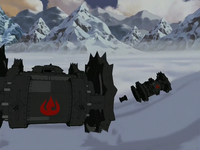
Fire Nation tundra tanks were used in the battle for the Northern Air Temple.
The most important heavy weapon the Fire Army employs is the tundra tank, the first mass-produced tank in the world and a light tank. These tanks are heavily armored and equipped with fire ports to allow the crew to launch fireballs, as well as two grappling hooks on the front. However, the unmodified tundra tanks are only able to fight infantry due to the lack of anti-tank or generally heavy weapons, thus their classification as light tanks. They are built with the main body separated from the tracks with a complicated hydraulic suspension which enables them to right themselves if flipped over, but leaves them vulnerable to waterbending and metalbending.
Tundra tanks are great all-around vehicles, able to be used in tundras, mountains, deserts, grassland and urban area. Although they are inferior to their counterparts, the earthbending-powered tanks of the Earth Kingdom, they are a serious threat, especially when they are used in joint companies with infantry.[30][40]
The drill[]
- Main article: Fire Nation drill
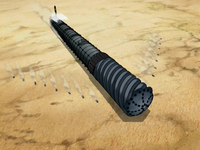
The drill was used to drill through the outer wall of Ba Sing Se.
This siege engine was a massive drill, designed to breach the Outer Wall of Ba Sing Se. The drill was originally modeled by the mechanist and took over two years to construct. As large as a village, it housed an entire brigade of Fire Nation engineers, who were needed to make repairs and clean out pipelines. The drill was composed of two moving parts which were connected by a series of braces. It worked by tearing chunks of stone from structures and grinding them down, dispensing them into water and channeling them out the rear.[64]
Strategies[]

During the Siege of the North, artillery weakened the defenses, while tundra tanks and cavalry broke the defenders, and infantry units secured the gained ground.
The Fire Army uses strategies that are similar to the characteristics of its representative element; it is highly mobile and aggressive in combat, but also acts clever and cunning, preferring complex strategies over brute force.[5]
A typical Fire Army strategy is as follows: Infantry companies of firebenders and nonbenders try to outflank their enemies, avoiding defenses too strong for them, using terrain and even environmental conditions like wind to their advantage. The infantry advances steadily, securing gained ground. At the same time, heavy units like tanks and cavalry act as spearheads and break the enemies' strongholds. If needed or available, artillery provides additional suppressive fire. In the best case the troops are able to encircle the enemy. When finally everything is ready to strike, the army carries the decisive attack out. Using all forces to overwhelm the enemy, the troops fight merciless and determined until the enemy is completely wiped out, securing another victory for the Fire Nation. In fact, the Fire Army is infamous for accepting collateral damage on civilians and their own troops.[5] Before Fire Lord Zuko's reign, it was even acceptable to sacrifice inexperienced troops to gain a battlefield advantage. This practice, however, ended under the populist Fire Lord.[16]